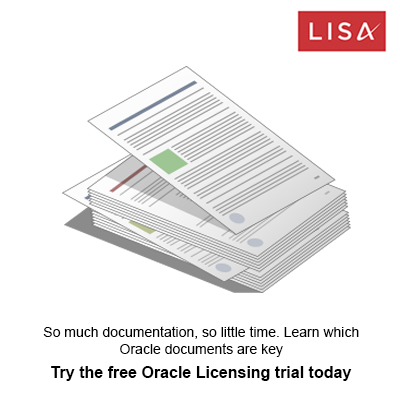Oracle ULA – Tips to achieving a successful exit

Tips to achieving a successful exit
This article has been contributed by Piaras MacDonnell of SureDatum. To learn more about Oracle Licensing, please join us in one of our upcoming events. Learn more here > https://marketplace.itassetmanagement.net/events/
An Oracle Unlimited License Agreement, Oracle ULA, is probably the most misunderstood of the enterprise license agreements. How come something that is supposed to be fixed price and unlimited end up costing you even more at the end of the agreement and in many cases forcing you to renew the ULA for another term?
Having helped a number of organisations successfully exit their Oracle ULA I thought I’d share with you a few of the lessons I’ve learnt. Hopefully they’ll help you to exit your ULA not only without any extra costs but having maximised the return on what is a significant investment.
Start Early
The typical Oracle ULA spans 3 year, 36 months, but most organisations don’t bother to actively manage their ULA until the last year or even the last 6 months!
At this point there is hardly enough time to figure out what is deployed never mind trying to make changes to reduce and increase return on investment.
You need to be actively managing the deployment of products covered by the ULA from the beginning of the agreement if you are going to have time to make all the changes.
Plan for Success
You have just spent several million on an asset and committed your company to further millions in support for many years to come. You now need to ensure that you get the returns to justify this spend.
The only way to achieve this is to establish a formal project over a 12-18 month period to monitor and manage the deployment of products covered by Oracle ULA and to actively reduce compliance risks for product that are not covered.
What gets measured get managed
When it comes to Oracle ULA’s the advice “what gets measured gets managed and what gets managed gets done” is very true. The 3 key metrics you need to be monitoring
- Cost per core per product – This metric demonstrates the value you are getting from the agreement on a product by product basis. It should be going down month by month as more products are deployed to the environment. This metric is of most interest to Procurement as it demonstrates contract performance.
- Number of Cores per product – This is a measure of deployment and favoured by the Technical Teams. The number of cores should be constantly increasing for products covered by ULA and either flat or decreasing for products not in ULA.
- Cost of Compliance Risk – This is a financial measure of any compliance risk that has been found to date. When the risk is mitigated only then does the number go down.
Use virtualisation to your advantage
Turn Oracle’s notoriously ridge rules on virtualisation to your advantage. You need to try to move or redeploy at least one instance of all products covered by the ULA onto all virtual hosts in your environment. This is a quick way to generate core licenses and easiest to harvest licenses later.
Something old, something new, something borrowed & something blue
As you come close to certifying your ULA (6 month or less) you want to deploy ULA products onto every available server in your network. So it may make sense to delay the decommissioning of server/hosts (something old), bring forward the implementation of new servers or CPU upgrades (something new), relaxing the rules on using servers dedicated to other vendors (borrowed) and reconfiguring your IBM LPARs to maximise cores that can be counted (blue).
 Actively manage products not covered by ULA
Actively manage products not covered by ULA
As you are optimising your estate to get the most value out of your ULA covered products you also need to ensure that you are not introducing risk (cost) by deploying products that are either capped or not covered. This needs to be actively managed from the start as once a product is in-use it can be very difficult to uninstall and reset the in-use settings.
Get license advice
You will need expert advice in Oracle licensing from a 3rd party, not Oracle LMS. You in-house team will not be up to date on the latest license rules and may not be familiar with how to calculate your deployment and entitlement.
A license advisor will also be able to help you to plan the optimal deployment of products as well as guide you if you need to make additional purchases.
Price Holds and Strategic Purchases
There is a high probability you’ll need to purchase additional license for products not covered by your Oracle ULA. The sooner you identify these gaps the better as you will be able to take advantage of price holds you may have negotiated or make a strategically timed purchase. You do not want to be negotiating a purchase when you’re at the end of your ULA.
Manage your Oracle Account Managers Expectations
You will need to let your Oracle account manager know, around T-6 months that you may not be renewing your Oracle ULA. It will avoid them putting it into their forecast and will speed up the certification process while taking pressure off to do a deal of some sort on exit.
Defending your certification
You can expect very close analysis of your declaration when you certify your Oracle deployment upon exiting the ULA. Oracle LMS will want detailed inventory records as well as wanting to interview the project team and ensure the process followed was both accurate and exhaustive.
Prepare to Wait
The official acceptance of your ULA certification can take 6 to 12 months. During this period you can expect a variety of enquiries from Oracle LMS and your Account manager as they attempt to sell more licenses.
Harvest your licenses
As soon as you receive formal certification from Oracle you will need to immediately start a new project to optimise your IT estate to free up all those Oracle licenses and make them available for future projects.
Conclusion
If an organisation gives themselves plenty of time and treat the management of their Oracle ULA as a project they can not only extract tremendous value from the license agreement but they can also create an Oracle license asset for the organisation that they can draw down from for years to come.
This article has been contributed by Piaras MacDonnell of SureDatum. To learn more about Oracle Licensing, please join us in one of our upcoming events. Learn more here > https://marketplace.itassetmanagement.net/events/


Thanks for this interesting article.
Any advises on servers that you have on Private or Public Cloud?